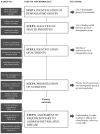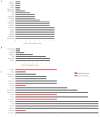Identification of Priority Nutrients in the US: Targeting Malnutrition to Address Diet-Related Disease Across the Lifespan
- PMID: 40573068
- PMCID: PMC12196107
- DOI: 10.3390/nu17121957
Identification of Priority Nutrients in the US: Targeting Malnutrition to Address Diet-Related Disease Across the Lifespan
Abstract
Background/Objectives: Poor diet is a leading modifiable cause of chronic disease in the US. In addition to targeting nutrients of concern (saturated fat, added sugars, and sodium), nutrients with both inadequate intakes and associations with major health outcomes require identification. We aimed to identify priority nutrients to address both malnutrition and diet-related disease in the US population. Methods: An established method for identifying priority nutrients across multiple demographic groups was adapted for the US population. This method evaluates and scores nutrients consumed at insufficient or excessive levels, with proposed revised requirements, and shows associations with established health priorities, based on the degree of deviation from recommendations and the number of linked health priorities. Priority nutrients were defined as those scoring in the top 25%. For each priority nutrient, a comparison of intake levels against the Dietary Reference Intake (DRI) was conducted. Results: There were 21 of 24 nutrients with consumption below recommended levels in at least one demographic group. Certain nutrients, such as dietary fiber, vitamin D, and choline, exhibited particularly high inadequacy rates, exceeding 90% throughout different life stages. The highest priority nutrients included vitamin D, vitamin E, calcium, magnesium, and dietary fiber, with vitamin D, omega-3 fatty acids, zinc, folate, and potassium showing priority for specific demographic groups. Comparing current intake levels with those known to benefit health priorities indicated that higher intakes of vitamin D, vitamin E, and calcium could be beneficial. Conclusions: Ten essential nutrients play a role in the prevention of diet-related disease, yet are consumed inadequately across the US population, suggesting that the prioritization of these nutrients can help to address the burden of chronic disease. Priority nutrients should be considered in diet and nutrition policies and guidelines.
Keywords: chronic disease; diet-related disease prevention; inadequate nutrient intake; increased nutrient requirements; malnutrition; priority nutrients.
Conflict of interest statement
The authors declare no conflicts of interest. All authors independently work for FOODiQ Global, which gains funding for projects from government, not-for-profits, professional, community, and industry organizations. All authors declare that the research was conducted in the absence of any commercial or financial relationships that could be construed as a potential conflict of interest. The funders had no role in the design of the study; in the collection, analyses, or interpretation of data; in the writing of the manuscript; or in the decision to publish the results.
Figures




Similar articles
-
Nutritional interventions for survivors of childhood cancer.Cochrane Database Syst Rev. 2016 Aug 22;2016(8):CD009678. doi: 10.1002/14651858.CD009678.pub2. Cochrane Database Syst Rev. 2016. PMID: 27545902 Free PMC article.
-
Effectiveness and safety of vitamin D in relation to bone health.Evid Rep Technol Assess (Full Rep). 2007 Aug;(158):1-235. Evid Rep Technol Assess (Full Rep). 2007. PMID: 18088161 Free PMC article.
-
Dietary intakes in relation to nutrition recommendations and dietary quality in an Iranian adult population: the results of the Food and Nutrition Surveillance (FNS).J Health Popul Nutr. 2025 Jul 26;44(1):268. doi: 10.1186/s41043-025-01022-x. J Health Popul Nutr. 2025. PMID: 40713780 Free PMC article.
-
Dietary interventions for recurrent abdominal pain in childhood.Cochrane Database Syst Rev. 2017 Mar 23;3(3):CD010972. doi: 10.1002/14651858.CD010972.pub2. Cochrane Database Syst Rev. 2017. PMID: 28334433 Free PMC article.
-
Vitamin D and calcium: a systematic review of health outcomes.Evid Rep Technol Assess (Full Rep). 2009 Aug;(183):1-420. Evid Rep Technol Assess (Full Rep). 2009. PMID: 20629479 Free PMC article.
References
-
- Chong B., Jayabaskaran J., Kong G., Chan Y.H., Chin Y.H., Goh R., Kannan S., Ng C.H., Loong S., Kueh M.T.W., et al. Trends and predictions of malnutrition and obesity in 204 countries and territories: An analysis of the Global Burden of Disease Study 2019. eClinicalMedicine. 2023;57:101850. doi: 10.1016/j.eclinm.2023.101850. - DOI - PMC - PubMed
-
- Afshin A., Sur P.J., Fay K.A., Cornaby L., Ferrara G., Salama J.S., Mullany E.C., Abate K.H., Abbafati C., Abebe Z., et al. Health effects of dietary risks in 195 countries, 1990–2017: A systematic analysis for the Global Burden of Disease Study 2017. Lancet. 2019;393:1958–1972. doi: 10.1016/S0140-6736(19)30041-8. - DOI - PMC - PubMed
MeSH terms
Grants and funding
LinkOut - more resources
Full Text Sources
Medical

